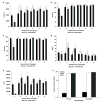T cell repertoire development in XSCID dogs following nonconditioned allogeneic bone marrow transplantation
- PMID: 17697962
- PMCID: PMC2034291
- DOI: 10.1016/j.bbmt.2007.05.013
T cell repertoire development in XSCID dogs following nonconditioned allogeneic bone marrow transplantation
Abstract
Dogs with X-linked severe combined immunodeficiency (XSCID) can be successfully treated by bone marrow transplants (BMT) resulting in full immunologic reconstitution and engraftment of both donor B and T cells without the need for pretransplant conditioning. In this study, we evaluated the T cell diversity in XSCID dogs 4 months to 10.5 years following BMT. At 4 months posttransplantation, when the number of CD45RA+ (naïve) T cells had peaked and plateaued, the T cells in the transplanted dogs showed the same complex, diverse repertoire as those of normal young adult dogs. A decline in T cell diversity became evident approximately 3.5 years posttransplant, but the proportion of Vbeta families showing a polyclonal Gaussian spectratype still predominated up to 7.5 years posttransplant. In 2 dogs evaluated at 7.5 and 10.5 years posttransplant, >75% of the Vbeta families consisted of a skewed or oligoclonal spectratype that was associated with a CD4/CD8 ratio of <0.5. The decline in the complexity of T cell diversity in the transplanted XSCID dogs is similar to that reported for XSCID patients following BMT. However, in contrast to transplanted XSCID boys who show a significant decline in their T cell diversity by 10 to 12 years following BMT, transplanted XSCID dogs maintain a polyclonal, diverse T cell repertoire through midlife.
Figures






Similar articles
-
Gene therapy studies in a canine model of X-linked severe combined immunodeficiency.Hum Gene Ther Clin Dev. 2015 Mar;26(1):50-6. doi: 10.1089/humc.2015.004. Epub 2015 Feb 24. Hum Gene Ther Clin Dev. 2015. PMID: 25603151 Free PMC article. Review.
-
Full immunologic reconstitution following nonconditioned bone marrow transplantation for canine X-linked severe combined immunodeficiency.Blood. 1997 Oct 15;90(8):3214-21. Blood. 1997. PMID: 9376605
-
Severe papillomavirus infection progressing to metastatic squamous cell carcinoma in bone marrow-transplanted X-linked SCID dogs.J Virol. 2006 Jul;80(13):6621-8. doi: 10.1128/JVI.02571-05. J Virol. 2006. PMID: 16775349 Free PMC article.
-
Bone marrow transplantation for canine X-linked severe combined immunodeficiency.Vet Immunol Immunopathol. 1999 Aug 2;69(2-4):137-44. doi: 10.1016/s0165-2427(99)00050-1. Vet Immunol Immunopathol. 1999. PMID: 10507301
-
Immune reconstitution and tolerance after allogeneic hematopoietic stem cell transplantation.Hematology. 2003 Feb;8(1):19-26. doi: 10.1080/1024533031000072045. Hematology. 2003. PMID: 12623423 Review.
Cited by
-
In Vivo Gene Therapy for Canine SCID-X1 Using Cocal-Pseudotyped Lentiviral Vector.Hum Gene Ther. 2021 Jan;32(1-2):113-127. doi: 10.1089/hum.2020.127. Epub 2020 Sep 23. Hum Gene Ther. 2021. PMID: 32741228 Free PMC article.
-
Evolution of haematopoietic cell transplantation for canine blood disorders and a platform for solid organ transplantation.Vet Med Sci. 2021 Nov;7(6):2156-2171. doi: 10.1002/vms3.601. Epub 2021 Aug 14. Vet Med Sci. 2021. PMID: 34390541 Free PMC article. Review.
-
Intravenous injection of a foamy virus vector to correct canine SCID-X1.Blood. 2014 Jun 5;123(23):3578-84. doi: 10.1182/blood-2013-11-538926. Epub 2014 Mar 18. Blood. 2014. PMID: 24642749 Free PMC article.
-
Gene therapy studies in a canine model of X-linked severe combined immunodeficiency.Hum Gene Ther Clin Dev. 2015 Mar;26(1):50-6. doi: 10.1089/humc.2015.004. Epub 2015 Feb 24. Hum Gene Ther Clin Dev. 2015. PMID: 25603151 Free PMC article. Review.
-
Effect of ex vivo culture of CD34+ bone marrow cells on immune reconstitution of XSCID dogs following allogeneic bone marrow transplantation.Biol Blood Marrow Transplant. 2009 Jun;15(6):662-70. doi: 10.1016/j.bbmt.2009.03.014. Biol Blood Marrow Transplant. 2009. PMID: 19450750 Free PMC article.
References
-
- Rosen FS, Cooper MD, Wedgwood RJ. The primary immunodeficiencies. N Engl J Med. 1995;333:431–440. - PubMed
-
- Buckley RH, Schiff RI, Schiff SE, et al. Human severe combined immunodeficiency: genetic, phenotypic, and functional diversity in one hundred eight infants. J Pediatr. 1997;130:378–387. see comments. - PubMed
-
- Fischer A, Haddad E, Jabado N, et al. Stem cell transplantation for immunodeficiency. Springer Semin Immunopathol. 1998;19:479–492. - PubMed
-
- Leonard WJ. The molecular basis of X-linked severe combined immunodeficiency: defective cytokine receptor signaling. Annu Rev Med. 1996;47:229–239. - PubMed
-
- Asao H, Okuyama C, Kumaki S, et al. Cutting edge: the common gamma-chain is an indispensable subunit of the IL-21 receptor complex. J Immunol. 2001;167:1–5. - PubMed
Publication types
MeSH terms
Substances
Grants and funding
LinkOut - more resources
Full Text Sources
Other Literature Sources
Medical
Research Materials

